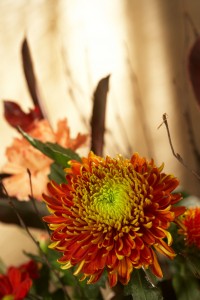Dahlia
 The Dahlia is a daisy-like flower that now has many hybrids around the world. It is related to the daisy as well as the sunflower and the chrysanthemum.
The Dahlia is a daisy-like flower that now has many hybrids around the world. It is related to the daisy as well as the sunflower and the chrysanthemum.
Pronounced DAY-lee-a, Dahlias were first recorded by Westerners in 1615, when they were called by their Mexican name, acoctli. They disappeared from record until 1787 when a botanical expedition ‘rediscovered’ them, and sent seeds back to their headquarters in Europe. Their existence was kept secret for another ten years however.
Description
Typically, the dahlia will have a single head atop a leafed stem that can grow to be as large as 30cm in diameter. The bright, vibrant colours are used in place of any kind of fragrance or scent to attract pollinating insects and birds.
Habitat
The Dahlia flower is native to Mexico and regions of South America – indeed, the variations in colour of this flower are particularly invocative of that continent.
Availability
The main season is the best time for the Dahlia, reaching full bloom in the mid-summer months and being available from June right through to October.
Species
Dahlias are members of the Asteraceae family and have been bred all over the world for many years, with a great number of the species straying quite far from the native forms of the flower.
Care Tips
There shouldn’t be much trouble trying to grow dahlias; they don’t require huge amounts of attention but they do need a lot of watering.
What they need is consistently moist soil and an abundance of sunlight. It is recommended that they are planted around eight inches apart if they are to be in groups.
Did you know?
Penzance in Cornwall is the home of the National Collection of Dahlias in the UK. The public can have the pleasure of seeing more than 10,000 dahlias in bloom for a few days in September every year.
The history of the dahlia is somewhat shrouded in mystery – an undocumented period of more than 150 years went by after the flower was first said to have been discovered by Westerners.
References
http://www.cooltropicalplants.com/Growing-dahlias.html


